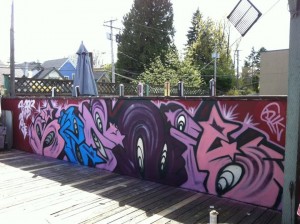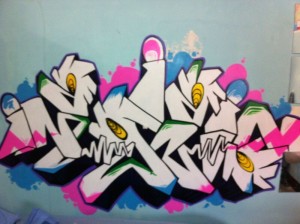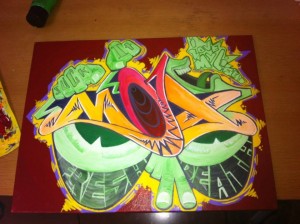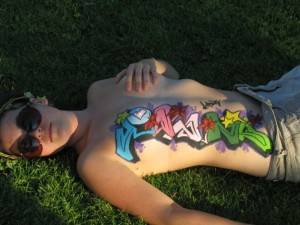The name “cnik” worked perfectly as a graffiti name. When a few friends and I started really getting into graffiti in the early 2000s, it was common to see new writers with wack names — smoke1 — reelkilla — crA-Z-8 — leaving sloppy hand-styles around town with (almost certainly) stolen paint.
We were lucky. One of my closest friends, who remains a close friend today, had a wayward desire when it came to boys, and in the 9th grade dated a man who was 10 years our senior. Looking back on it now, the age gap between 14 and 24 is creepy to say the least, and probably illegal. But at the time we were more than supportive of their relationship. The guy was “Answer”, a graffiti legend in our podunk city, who had connections with some heavy graffiti crews all across Canada.
When you think of a grown man hanging out with middle school kids, you probably think of a skinny dude with a duster mustache, a beat up trans-am, and cheeto-stained fingers. Answer wasn’t like that at all. Tall, muscular, well-dressed in a hip-hop style. But the thing that really stuck out was how genuinely friendly he was. The first time I met him he came with a sketchbook and a pile of markers, and straight dropped graffiti-science on me.
“When you pick a name, it’s gotta have multiple spellings. Homophones, I think that’s called. You only get one name for your whole time in this game. To switch up is like pressing a restart button, and you’ll lose a lot of respect from other writers. So the name you choose is real important, and at some point you’re gonna get bored with those same letters, so it’s best to stay prepped for that.
“Now once you got your name, that’s when things get real. Every good writer wants to pretend like they were throwing up the hottest stuff straight out the gate, but that’s all lies. Everybody starts off a toy. A toy — that’s what you are now. You don’t have a style of your own. You’re being played with by other writers’ styles that you’re stealing and trying to pass off as your own. And there’s nothing wrong with that, it’s where we all start. Writers are gonna hate on you, cross out your stuff, and there’s nothing wrong with that either. All you have to remember is keep writing. New designs, new letter styles, new, new, new, new, new! Never create the same thing twice. That shows you’re getting an ego and your style’s getting stale. If you do something you hate, throw it out and never do it again. If you do something you love, throw it out and never do it again. It’s all about the newness, and there’s nobody to regulate that except you.”




***
This was all happening before social media was a thing. I think MySpace had just come out, but it didn’t have much of an impact on anybody I knew. But in the graffiti world, there were two incredible collaboration tools that completely sucked me in.
The first was called Vandal Squad. Think of Microsoft Paint, adapted to the idiosyncrasies of a spray paint can, and applied to a virtual train yard with about 100 trains. You would log in to the site, and could either watch the trains go by with the graffiti that other writers had made, or choose a train that you wanted to paint over. Pretty quickly, crews formed, and would do collaborative pieces on a train, or sometimes multiple trains, from computers all over the world. Writers actually gained a significant presence, and within a couple years there were well-known/famous writers doing work in the virtual yard. Online wars also started, as there were a limited amount of trains, so every time a new piece was done, somebody’s piece was covered.
The second tool was called Playdo Graffiti. The interface was a lot similar to the blank palette and tools offered by Microsoft Paint. But there were 1000s of walls that worked like live chat rooms — you pick a wall, do your art, and other people can see your mark and do their own thing as well. Much like chat rooms, as well as comment feeds on today’s social media sites, there was a lot of hate. But the coolest part of Playdo were the art battles. You could go into a wall, challenge someone to an art battle on a different wall, go to the agreed upon wall, split the screen in half, and may the best artist win. (Playdo still exists, but only as a single-user wall. Collaboration doesn’t last forever, I suppose. Here’s the link http://graffiti.playdo.com)
***
I’m writing this with a recent class conversation in mind. The question was asked, “Can Facebook be used as a professional collaborative/creation tool?” The (almost) unanimous answer was no, it can’t be, and that tools like Google Docs and email are preferable.
Maybe I misunderstood the question. Or maybe I’m just plain crazy. But to consider Google Docs and email as arenas to inspire fun and creativity is beyond my mental reach.
To frame my response differently, it’s important to consider a common theme ingrained in social media and a professional setting — there’s not enough time or money to make it happen during the workday. So does that mean no social media collaboration for professionals ever? Nahhhh. Nobody likes a quitter.
Rewind to my conversation with Answer. I wanted to do graffiti, to get better at graffiti, for no other reason than wanting to. I like creating things. I think people who create things are the driving force of society and social change. When you look at a tenured professors publication list, how many of those thousands of hours spent writing were “paid” hours?
I’d like to think, unoptimistically, that there’s a good amount of librarians out there who want to create for creation’s sake. That after a day’s work, they come home and want to make something — a research paper, a twitter bot, a website… And wouldn’t it be cool if these librarians had a place, outside the reference desk, to share ideas and and collaborate with other likeminded librarian-creators?
It would need to be a place that everybody was already familiar with. That made it easy to share files, pictures, music, videos, and other types of media. That was simultaneously easy to for people to find, and easy to find people. If only such a place existed…
My reaction to the second half of your post Nick is, to quote boyd, “…it’s complicated”. I am continually surprised at the reactions of my colleagues towards using digital tools, platforms and the like.
One of the themes that come out of the conversation is that there is no panacea. Also context(s) are critical. We can find solutions if we keep those ideas uppermost.
As an individual, you can use social tools to communicate with anyone you want and create anything you want. My two cents.